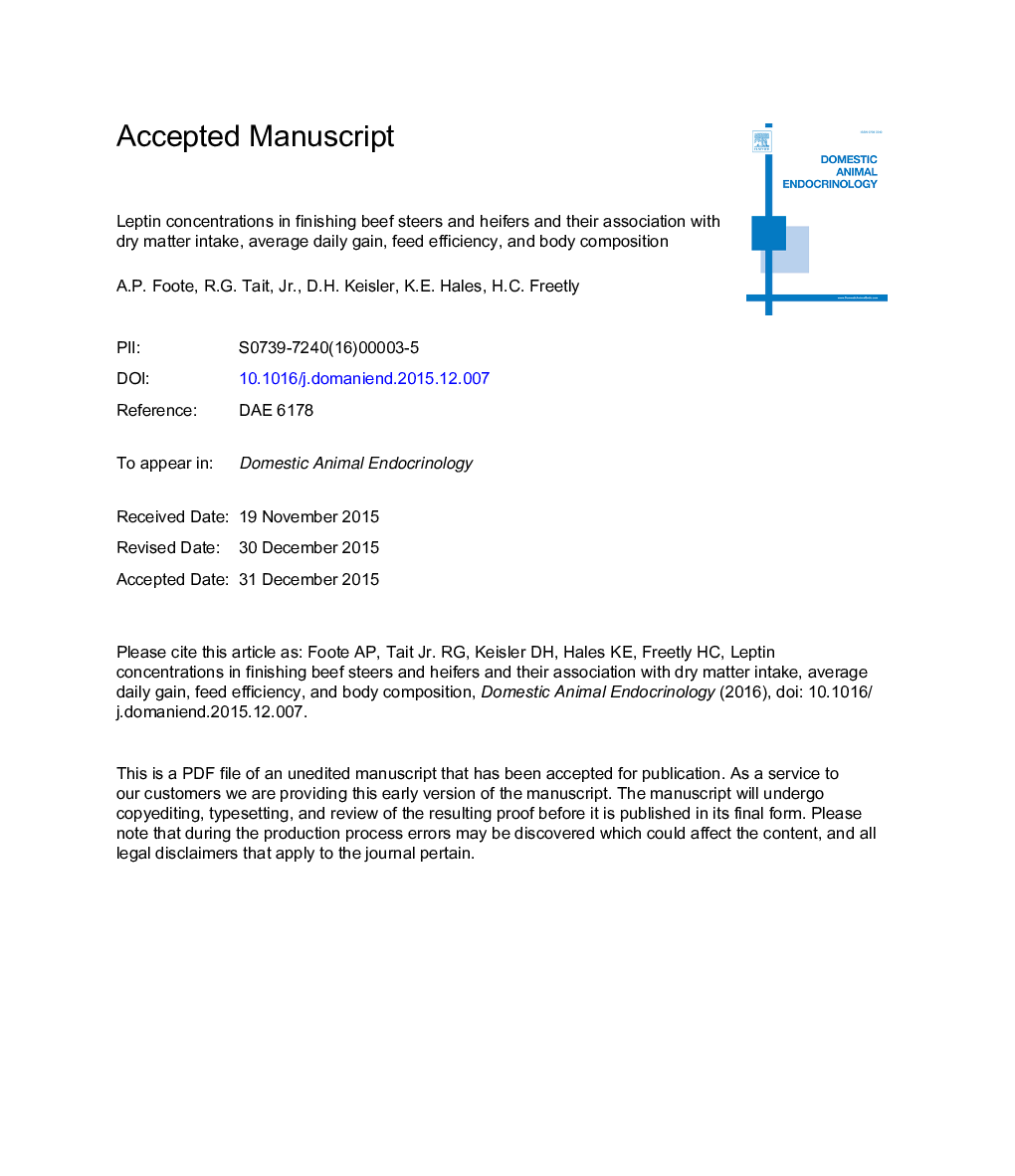| کد مقاله | کد نشریه | سال انتشار | مقاله انگلیسی | نسخه تمام متن |
|---|---|---|---|---|
| 8482099 | 1551504 | 2016 | 25 صفحه PDF | دانلود رایگان |
عنوان انگلیسی مقاله ISI
Leptin concentrations in finishing beef steers and heifers and their association with dry matter intake, average daily gain, feed efficiency, and body composition
ترجمه فارسی عنوان
غلظت لپتین در نان گوشت گاو و تلیسه ها و ارتباط آنها با مصرف ماده خشک، میانگین روزانه، بازده خوراک و ترکیب بدن
دانلود مقاله + سفارش ترجمه
دانلود مقاله ISI انگلیسی
رایگان برای ایرانیان
کلمات کلیدی
گاو گوشت گاو، راندمان خوراک، مصرف خوراک، رشد لپتین،
موضوعات مرتبط
علوم زیستی و بیوفناوری
علوم کشاورزی و بیولوژیک
علوم دامی و جانورشناسی
چکیده انگلیسی
The objective of this experiment was to determine the association of circulating plasma leptin concentrations with production and body composition measures of finishing beef steers and heifers and to determine if multiple sampling time points improve the associations of plasma leptin concentrations with production and body composition traits. Individual dry matter intake (DMI) and ADG were determined for 84 d using steers and heifers (n = 127 steers and n = 109 heifers). Blood was collected on day 0, day 42, and day 83 for determination of plasma leptin concentrations. Leptin concentrations were greater in heifers than those in steers on day 0 (P < 0.001 for sex by day interaction), and leptin concentrations increased in both sexes but were not different from each other on day 83. Leptin concentrations at all 3 time points and the mean were shown to be positively associated with DMI (P ⤠0.006), whereas the mean leptin concentration explaining 8.3% of the variance of DMI. Concentrations of leptin at day 42, day 83, and the mean of all 3 time points were positively associated with ADG (P ⤠0.011). Mean leptin concentration was negatively associated with gain:feed ratio and positively associated with residual feed intake (RFI), indicating that more efficient cattle had lower leptin concentrations. However, leptin concentrations explained very little of the variation in residual feed intake (â¤3.2% of the variance). Leptin concentrations were positively associated with body fat measured by ultrasonography at the 12th rib and over the rump (P < 0.001), with the mean leptin concentration explaining 21.9% and 12.7% of the variance in 12th rib and rump fat thickness, respectively. The same trend was observed with carcass composition where leptin concentrations were positively associated with 12th rib fat thickness, USDA-calculated yield grade (YG), and marbling score (P ⤠0.006) and mean leptin concentration explained 16.8, 18.2, and 4.6% of the variance for 12th rib fat thickness, yield grade, and marbling score, respectively. Given these and previous results, it appears that leptin physiology could be a candidate for mechanisms that contribute to feed intake and feed efficiency variation in beef cattle.
ناشر
Database: Elsevier - ScienceDirect (ساینس دایرکت)
Journal: Domestic Animal Endocrinology - Volume 55, April 2016, Pages 136-141
Journal: Domestic Animal Endocrinology - Volume 55, April 2016, Pages 136-141
نویسندگان
A.P. Foote, R.G. Jr., D.H. Keisler, K.E. Hales, H.C. Freetly,
